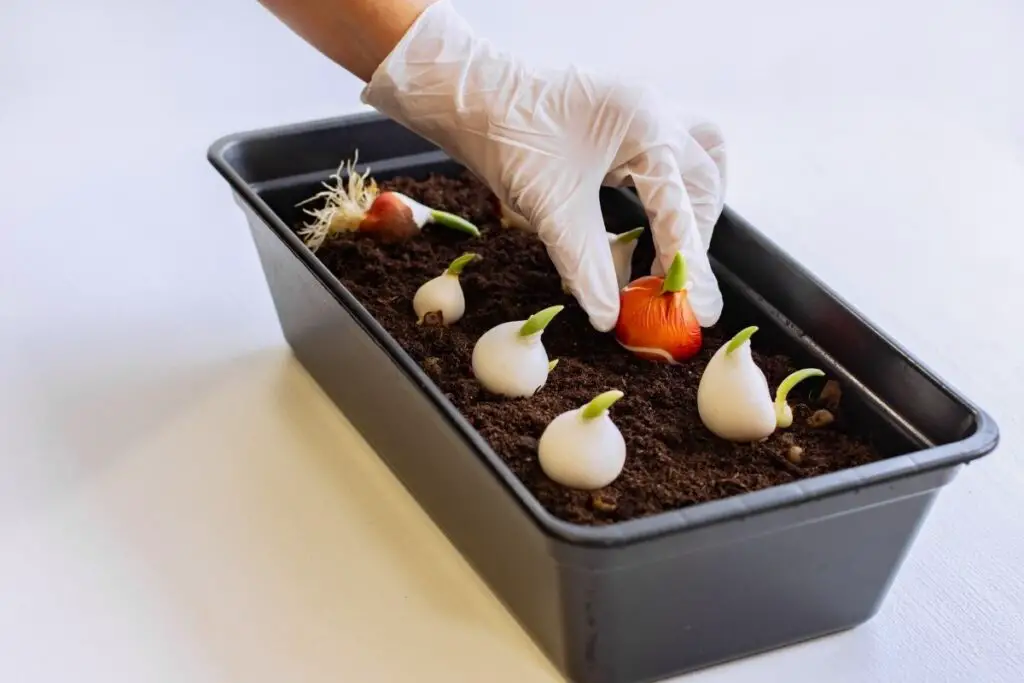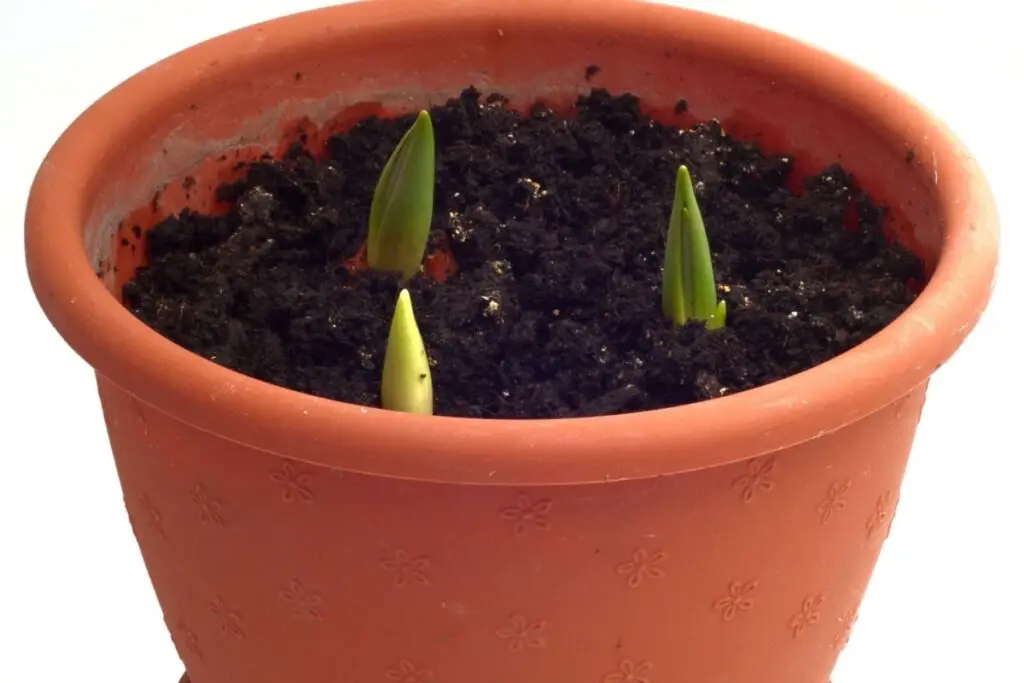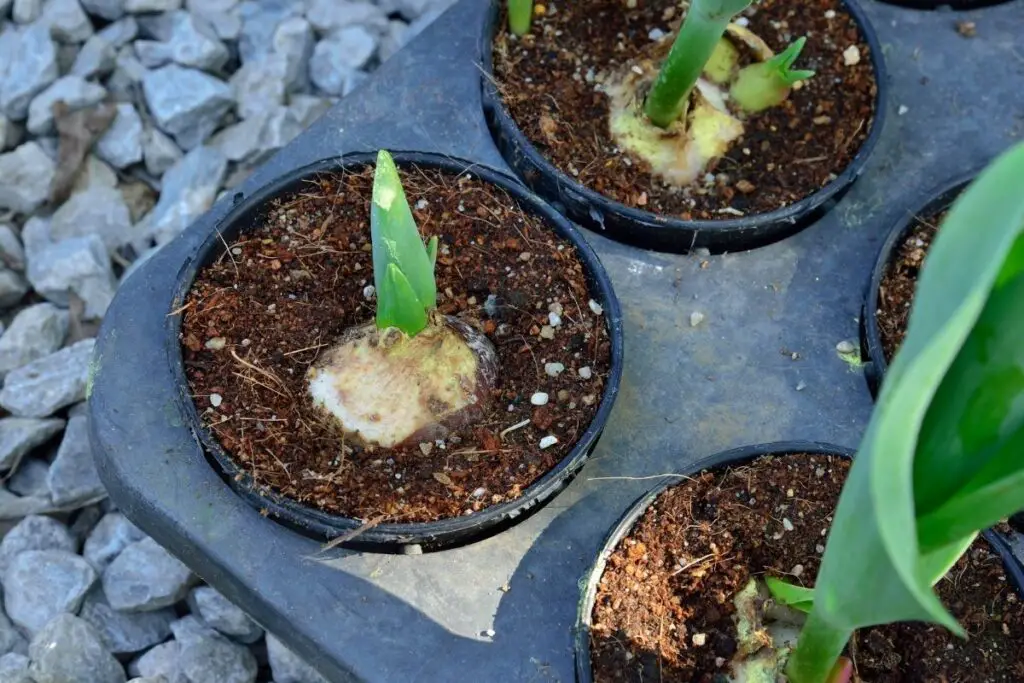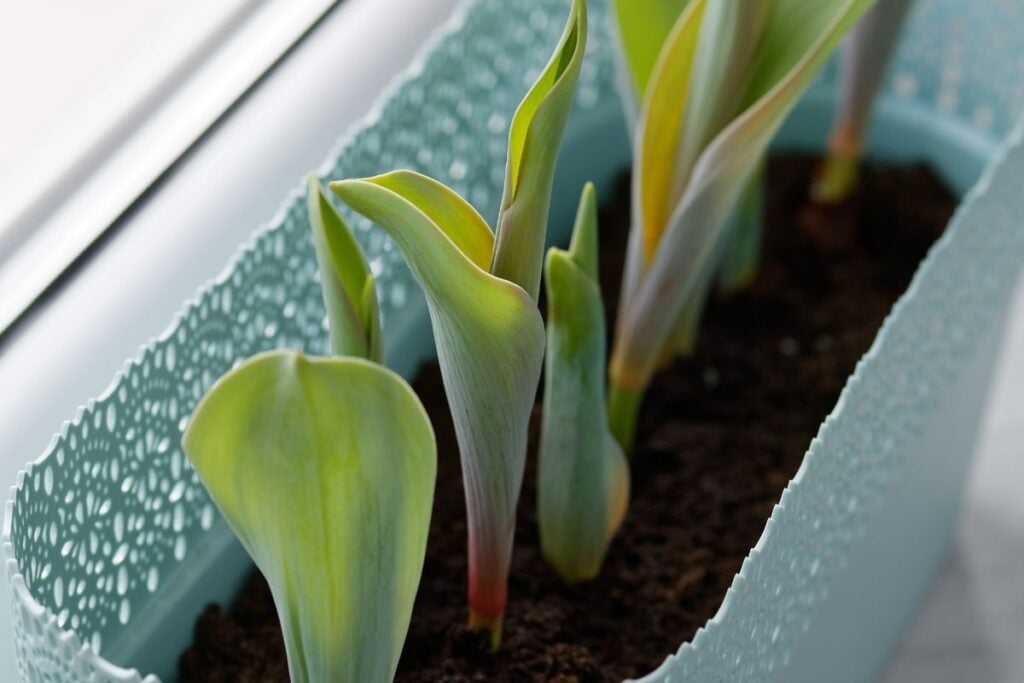Tulips are famous outdoor plants that come in various colors. Tulips are grown from bulbs and seeds, and each method generates a different result from one another.
In this article, we shall learn when to plant tulips seeds and we will also cover the care details.
Tulips seeds are primarily planted in Autumn once the temperature in your area goes below 55°F. September-November is the ideal month, depending on where you live. You also need to keep them in a cold frame and cover them lightly with moist soil to have appropriate conditions to germinate.
Tulips grown from bulbs will flower the following spring, whereas seeds may take 2 to 3 years or more to bloom. The growth of tulips from seeds will largely depend on the environmental conditions around them.
In this article, we will discuss the planting times of tulip seeds. We will also understand the various factors that affect the tulips grown from seeds.

What is the best climate for growing tulips from seeds?
Tulip growing from seeds prefer to be in a climate of cold winters and hot, dry summers. They will not grow well if places have wet, cool summers or warm winters.
They don’t like too humid regions, and therefore it is essential to ensure that you take as much effort to keep them within their natural environmental conditions.
Warmer temperatures in springtime trigger rapid growth in them and help produce stems and flowers.
What are the different hardiness zones for planting tulips?
Tulips prefer cold weather for propagation, and so you need to provide them with special care if you want to grow them in warmer zones.
If you are from USDA hardiness zones 8-10, you may need to chill your tulip bulbs before planting them, and for that, you need to keep them in a paper bag inside the refrigerator for 6-8 weeks.
You need to keep them away from ripe fruits, especially apples, as they emit ethylene gas that can kill the bulbs.
The most suitable time for planting tulips in the soil is when the soil temperature is below 60°F.
However, some tulips grow under warmer climates like lady tulips or Florentine tulips.
Let’s look into the planting time for growing tulips in different zones.
- Zones 4 and 5: September to early October.
- Zones 6 and 7: October to early November.
- Zones 8 and 9: November to early December.
- Zone 10: Late December to early January.
Also read: What Temperature Do Tulips Need? (+Growing Them At Different Temperature)
How long do tulips take to grow from seeds?

Tulips can take 8-12 months to propagate from seeds. If the seeds germinate within 2-3 months of sowing, it means that they are in an ideal condition.
You can wait for more than 6 months to see them germinate. They will later require several months to 1 or 2 years for the seedlings to develop into tulip plants. You can transplant them only when they form a proper dry shell covering over them.
If you find tulips with a light-colored or a cream bulb, do not transplant them, as they are not strong enough to survive transplantation.
It should be brown and hard to touch. Accumulatively, the seeds can take 1-2 years to develop into mature tulip plants. Sometimes this period can extend up to 6-7 years before they produce flowers.
Even after these years, blooming in tulips is quite uncertain if propagated from seeds.
Looking for gardening supplies? We have tested 100's of products before recommending them to you guys. Check out our best pick below:
| Image | Gardening Supplies | Best Price? |
|---|---|---|
 Top
Top Top
Top | Raised Garden Bed Kit | Check On Amazon |
 | XLUX Soil Moisture Meter, Plant Water Monitor, Soil Hygrometer Sensor for Gardening, Farming, Indoor and Outdoor Plants, No Batteries Required | No Results |
 Top
Top Top
Top | 82 Pcs Garden Tools Set and Extra Succulent Tools Set | Check On Amazon |
 | Joeys Garden Expandable Garden Hose with 8 Function Hose Nozzle, Lightweight Anti-Kink Flexible Garden Hoses, Extra Strength Fabric with Double Latex Core, (50 FT, Black) | No Results |
 Top
Top Top
Top | Dual Chamber Compost Tumbler | Check On Amazon |
 Top
Top Top
Top | Sunnyglade Plant Stakes | Check On Amazon |
 Top
Top Top
Top | Organic Cold Pressed Neem Seed Oil | Check On Amazon |
 Top
Top Top
Top | Mighty Mint Gallon :-Insect and Pest Control Peppermint Oil | Check On Amazon |
 Top
Top Top
Top | Scotts DiseaseEx Lawn Fungicide | Check On Amazon |
 Top
Top Top
Top | Jacks Classic 20-20-20 All Purpose Fertilizer | Check On Amazon |
 Top
Top Top
Top | 30,000 Seeds Pollinator Attracting Wildflower Mixture | Check On Amazon |
 Top
Top Top
Top | Survival Vegetable Seeds Garden Kit-Over 16,000 Seeds | Check On Amazon |
How do tulip bulbs grow from seeds?
Growing tulips from seeds is a long process, but if you have patience and want to experiment, sow the seeds and wait for them to develop.
Let’s discuss the steps involved in this process.
- Once your tulips have bloomed, allow them to dry out and wither if you want to grow tulips from seeds.
- After some days, you will find that their pods have turned brown.
- Then carefully open the pods, take out the seeds, and leave them in a dish for about a week.
- Once the seeds have dried out after a week, move them into a plastic bag and surround it with a damp paper towel.
- Place the bag in the refrigerator for some months. This will create a dormancy period for the seeds.
- Next, you should take the seeds out of the bag and plant them in small pots filled with well-drained compost.
- Cover the seeds with ½ inch of soil and keep them under the sun or in a south-facing frame.
- Keep the pot watered and add a substantial amount of slow-release liquid fertilizer every year.
- If you find that your tulip seeds have grown a minimum of 2 leaves, it means that the seedlings are now ready to move outdoors.
- You can now transplant your tulips in the garden. The maturity period will be around 12-15 months.
- Tulips’ root systems are pretty delicate, so you need to be careful while touching them. If you find new bulbs are brown, then plant them in Autumn.
- Check your hardiness zones and provide them with the correct environmental requirements.
When should you plant tulips bulbs?

Tulips are spring bloomers, and they remain dormant in summer when the weather is too hot.
They won’t grow their roots in summers. Also, they don’t like heavy moisture as this can make their bulbs stressed and susceptible to root rot.
But when fall arrives, the weather turns cool and becomes nice, and at that time, the bulbs trigger themselves to set their roots and make them well-established throughout the colder temperatures.
In cold weather places in zones 4-7, you can plant them when the ground is cool and soil temperature is between 40-50 °F but plants them 6 to 8 weeks before the ground freezes.
However, you can plant summer-blooming tulip varieties from mid to late spring.
In warmer places in zones 8-10, you need to chill your tulips bulbs by storing them in a refrigerator for 6-8 weeks before planting them.
Also read: When’s The Best Time To Plant Tulips? (+After Plant Care)
What factors will influence the growth of tulips seeds?
Factors that play essential roles in the growth of tulips seeds are:
- Sunlight
- Water
- Soil
- Fertilizers
Let us discuss each point briefly.
Sunlight
If you are growing tulips from seeds, you need to keep them in a cold frame for about 18 months from when they are sown. The seed will develop into seedlings after 7-8 weeks after sowing.
Plant the seedlings the following fall and consider keeping them in pots outside and provide at least 6 hours of direct sunlight daily.
Provide them with some partial shade during the hottest part of the day as they do not like too much heat, and overbearing sun can harm your tulips.
Also read: How Much Sunlight Do Tulips Need? (Tulip Light Needs)
Water

Water is essential for the germination of tulips seeds. So you need to provide their seeds with an inch of water every week to keep them moist.
Do not overwater your tulips as they can’t stand in soggy soil, and they will get root rot problems.
During the winter months, you need to water them whenever the soil feels dry below the surface.
Provide them with enough water until you find the moisture starts to drip from the bottom of the pot.
Also read: How Often Do Tulips Need To Be Watered? (Tulip Watering Needs )
Soil
The best soil for tulips is well-draining sandy or loamy soil with a mix of organic matter. Tulips will thrive in neutral, less acidic soil with a pH value ranging from 6.0 to 7.0 on the pH scale.
Tulips need soil that will provide enough nutrients to help them develop healthy and strong root systems. Also, the soil should be light and loose so that the roots can enjoy proper airflow.
To grow tulips from seeds, you need to determine the soil composition for the cold frame. You can use light sandy soil or make a mixture by mixing:
- 30% of potting soil
- 30% of compost
- 20% of peatmoss
- 20% of sand
After that, when you transplant the seedlings outdoors, place them in a soil mix composed of sand, peat moss, and manure compost. Add more compost if the soil is sandy or clayey.
Tulips will require an appropriate soil for growth, and a wrong soil mix will cause poor growth of tulips, drooping and wilting of their leaves.
Also read: What Kind Of Soil Is Good For Tulips? (Best Soil Mix)
Fertilizers
Fertilization is required for the tulip seedlings to develop their first set of leaves and overall healthy growth.
You can use a slow-release liquid fertilizer with a nutrient ratio of 10:10:10 for your tulips. Use fertilizers in the fall after planting and when the seed germinates in the spring.
While transplanting, you can use a low nitrogen plant food that works well with the soil. Provide them with sufficient food each subsequent year to grow their leaves.
While fertilizing tulips, ensure that the nutrient level is perfectly balanced, including essential nutrients like nitrogen, phosphorus, and potassium.
Always use a balanced fertilizer to avoid the problem of over-fertilization.
Also read: What Is The Best Fertilizer For Tulips? (Organic+Inorganic)
How do tulips propagate?
You can propagate Tulips with two methods. These two methods are:
Division: The most common method of tulip propagation is division. Here they grow from bulbs, the most preferred method of propagating them.
They are primarily propagated in Autumn as they need a long chilling period before they flower.
To grow tulips from bulbs, you must ensure that the soil temperature is below 55°F, and nighttime temperatures should be around 40-50°F.
To propagate tulip bulbs, you need to plant them in a sunny garden bed and well-draining soil.
They should be spaced 1-6 inches apart in garden beds. Tulips grown from bulbs will bloom in the following spring after planting.
Seeding: Propagation of tulips from seeds is relatively uncommon. Tulips can hybridize readily, and the flowers produced by seeds are not similar to the parent plant.
But if you want to do experiments and produce a new tulip variety, you can opt for this method.
Start growing seeds in Autumn when night temperatures are between 40-50°F. You can grow seeds in containers as it will become easier to control their growing environment.
Tulips seeds can start germinating within a few months but may take 5- 7 years to bloom.
Final thoughts
You can plant your tulip seeds in the Autumn, and they will take 2-3 months to germinate. Tulips growing from seeds prefer cold climatic conditions for propagation and require special care in warmer zones.
Tulips growing from seeds is a relatively slow process. They will take several months to 1-2 years to develop into tulip plants, and then they will take another 2-3 or more years to bloom.
The growth of tulips largely depends on environmental conditions, such as sunlight, water, soil, and fertilizers. Ensure that you provide your tulips with direct sunlight, well-draining rich soil, enough watering, and good nutrition for their overall development.
Source: Wikipedia, North Dakota Stae University, The Royal Horticultural Society.
